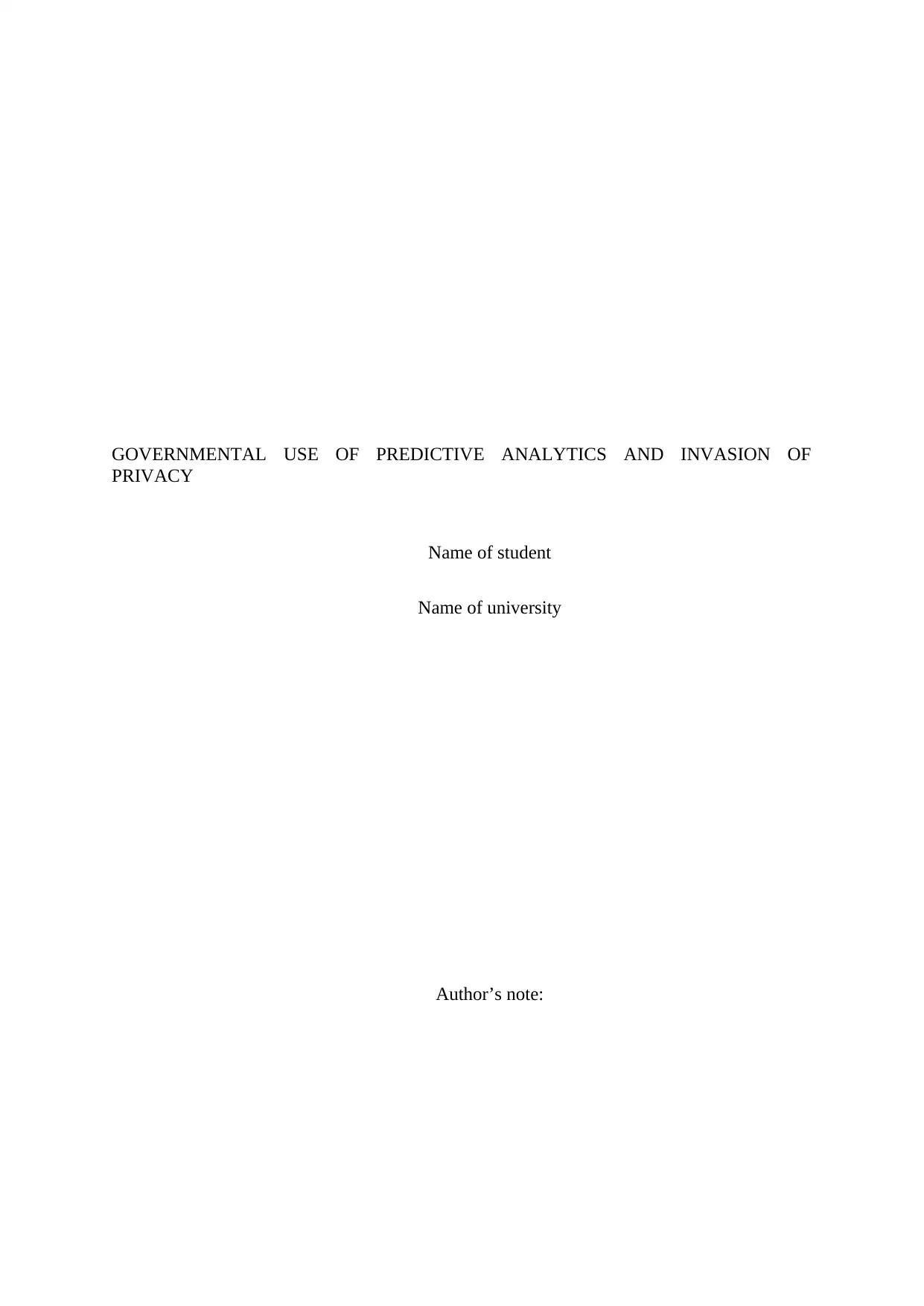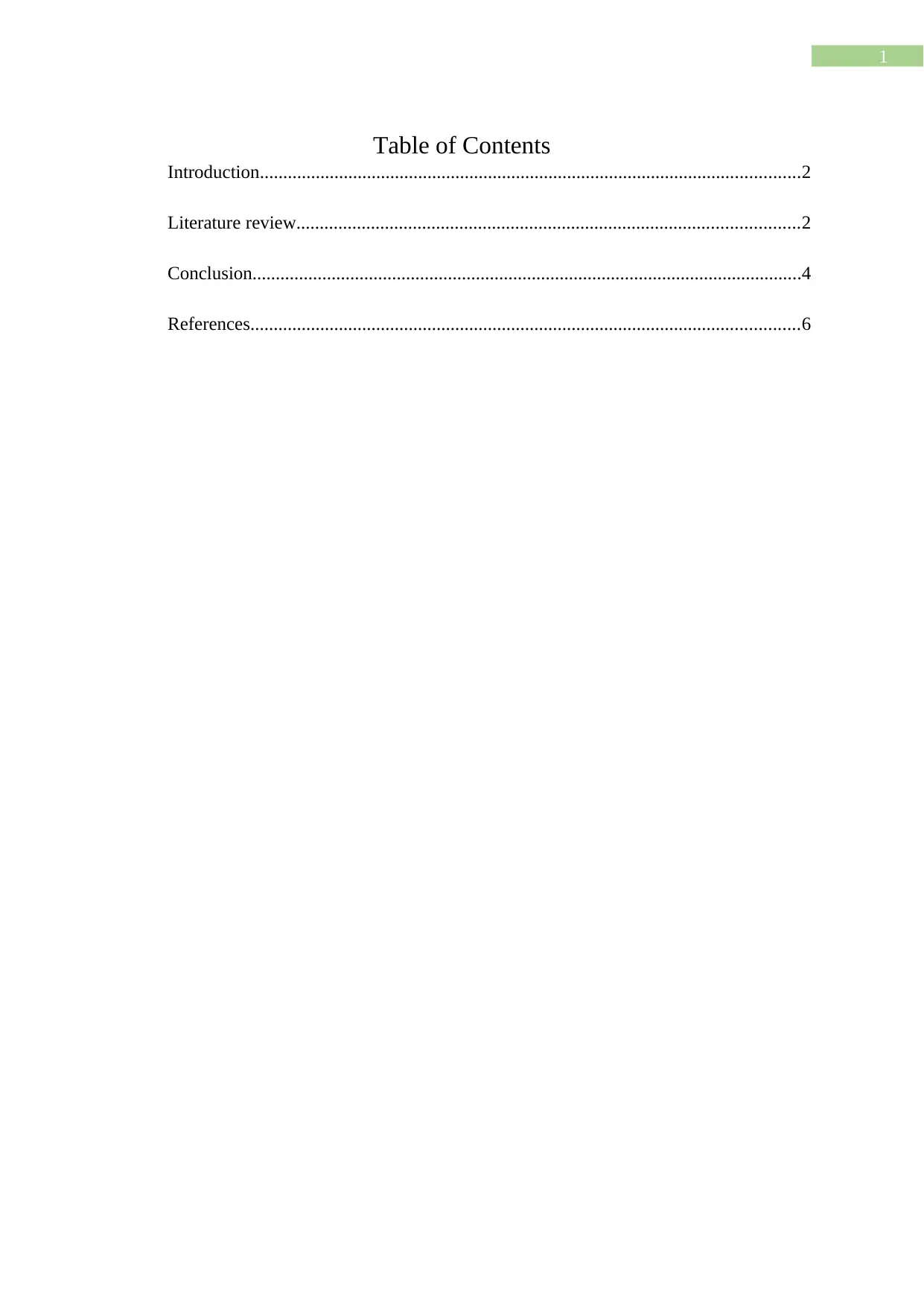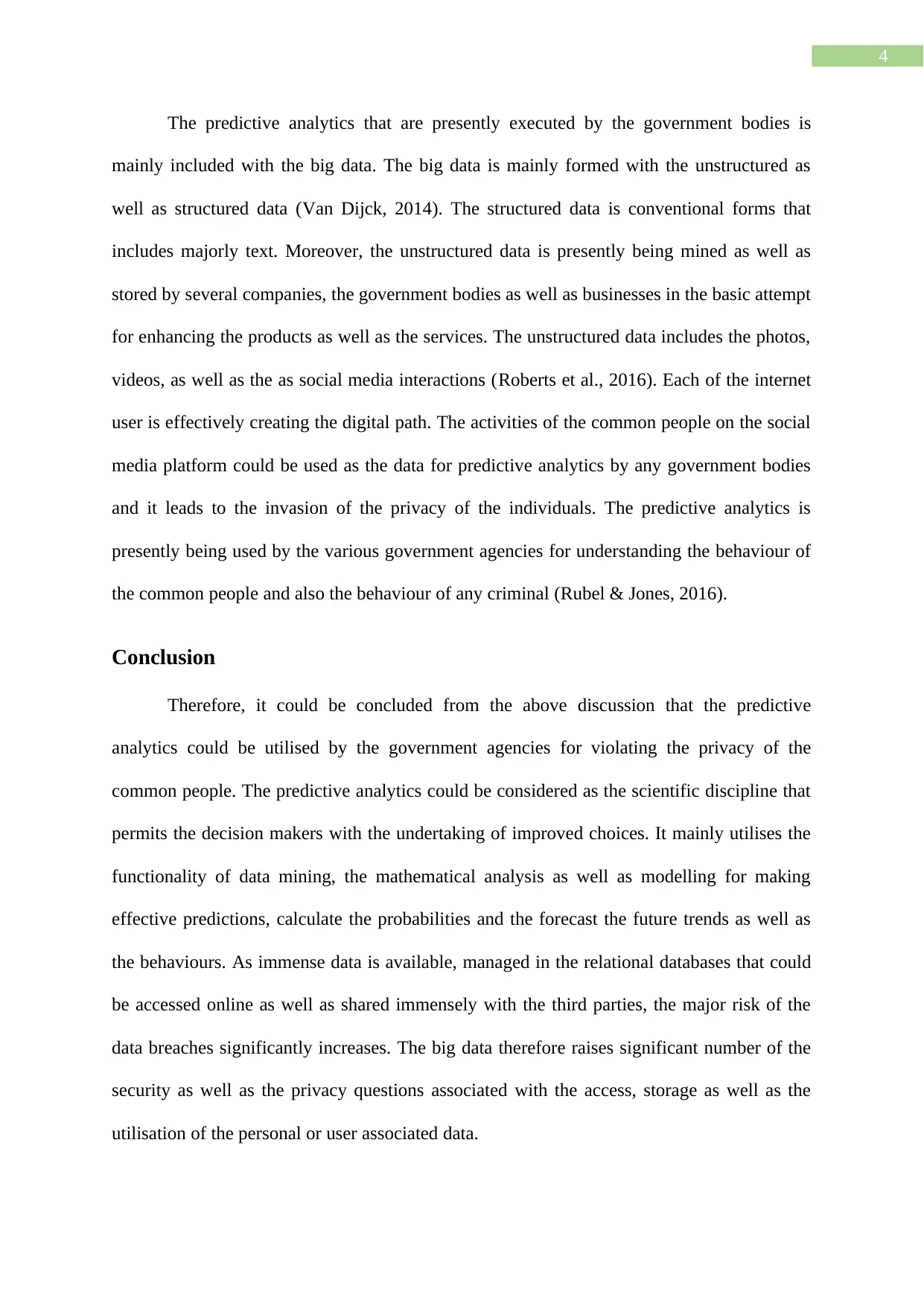Predictive Analytics and Privacy: A Governmental Perspective
VerifiedAdded on 2022/11/23
|7
|1412
|66
Report
AI Summary
This report provides a literature review on the governmental use of predictive analytics and its implications for privacy. It explores how governments leverage artificial intelligence, machine learning, and big data to predict and anticipate problems, ranging from fraud detection to addressing public health crises. The report discusses the capabilities of predictive analytics in various sectors, including security, healthcare, and human services. It highlights the ethical and privacy concerns arising from big data, such as data breaches and the potential erosion of civil liberties. The report also examines the risks associated with the collection, storage, and utilization of personal data, including the manipulation of individuals and the invasion of privacy. It concludes that while predictive analytics offers valuable tools for decision-making, it also poses significant challenges to individual privacy and data security.

GOVERNMENTAL USE OF PREDICTIVE ANALYTICS AND INVASION OF
PRIVACY
Name of student
Name of university
Author’s note:
PRIVACY
Name of student
Name of university
Author’s note:
Paraphrase This Document
Need a fresh take? Get an instant paraphrase of this document with our AI Paraphraser

1
Table of Contents
Introduction....................................................................................................................2
Literature review............................................................................................................2
Conclusion......................................................................................................................4
References......................................................................................................................6
Table of Contents
Introduction....................................................................................................................2
Literature review............................................................................................................2
Conclusion......................................................................................................................4
References......................................................................................................................6

2
Introduction
This report intends to provide an extensive literature review on the governmental use
of predictive analytics and invasion of privacy. The utilisation of artificial intelligence as well
as the predictive analytics permits the governments to specifically target the likely problems
prior it erupts into the crises. The recent developments in the natural language processing, the
machine learning as well as the image and speech recognition have provided to opportunity to
the government for predicting and anticipating the problems instead of just reacting on the
problems. Form the spotting of fraud to the combatting of the opioid epidemic, any
significant ounce of the prevention significantly work any pound of cure specifically in the
government. The predictive analytics is presently being applied in the vast range of the areas
that includes the security, defence, healthcare as well as the human services.
Literature review
The predictive analytics could be considered as the scientific discipline that permits
the decision makers with the undertaking of improved choices. It mainly utilises the
functionality of data mining, the mathematical analysis as well as modelling for making
effective predictions, calculate the probabilities and the forecast the future trends as well as
the behaviours (Sprague, 2015). When it is properly implemented, the predictive solution
could inform a repeatable as well as automated process that concludes an unbiased
conclusion free of the human subjectivity. The predictive analytics is mainly executed with
the help of the big data that is collected from within the organisation and then it is utilised for
executing the predictions. While rise of the big data yields significant opportunities for the
individuals, the organisations as well as the society at large, it also increases the importance
of the ethical and privacy issues (Sprague, 2014). These particular issues are the factors that
might lead to the situations where any underlying models of analytics as well as the
Introduction
This report intends to provide an extensive literature review on the governmental use
of predictive analytics and invasion of privacy. The utilisation of artificial intelligence as well
as the predictive analytics permits the governments to specifically target the likely problems
prior it erupts into the crises. The recent developments in the natural language processing, the
machine learning as well as the image and speech recognition have provided to opportunity to
the government for predicting and anticipating the problems instead of just reacting on the
problems. Form the spotting of fraud to the combatting of the opioid epidemic, any
significant ounce of the prevention significantly work any pound of cure specifically in the
government. The predictive analytics is presently being applied in the vast range of the areas
that includes the security, defence, healthcare as well as the human services.
Literature review
The predictive analytics could be considered as the scientific discipline that permits
the decision makers with the undertaking of improved choices. It mainly utilises the
functionality of data mining, the mathematical analysis as well as modelling for making
effective predictions, calculate the probabilities and the forecast the future trends as well as
the behaviours (Sprague, 2015). When it is properly implemented, the predictive solution
could inform a repeatable as well as automated process that concludes an unbiased
conclusion free of the human subjectivity. The predictive analytics is mainly executed with
the help of the big data that is collected from within the organisation and then it is utilised for
executing the predictions. While rise of the big data yields significant opportunities for the
individuals, the organisations as well as the society at large, it also increases the importance
of the ethical and privacy issues (Sprague, 2014). These particular issues are the factors that
might lead to the situations where any underlying models of analytics as well as the
⊘ This is a preview!⊘
Do you want full access?
Subscribe today to unlock all pages.

Trusted by 1+ million students worldwide

3
infrastructures are probably considered to impact the privacy negatively from both the legal
as well as the perspective of ethics as therefore, it represents probable hurdles for the
potential of big data. The significant retention of the socioeconomic, the behavioural,
demographic, financial as well as other data of the transaction for the purposes of the
analytics might lead to erosion of the civil liberties due to loss of the privacy as well as the
individual autonomy. From the perspective of security as well as the privacy, the major
challenge is the ensuring that the data subjects have the sustainable control over the data for
preventing the misuse as well as the abuse by the data controllers with the preservation of the
data utility and therefore the value of the big data for the discovery of knowledge or patterns,
economic as well as innovation growth (Crawford & Schultz, 2014). The predictive analytics
could be utilised by the government bodies for the manipulation of the common people and
allow the invasion of privacy of the common people. As immense data is available, managed
in the relational databases that could be accessed online as well as shared immensely with the
third parties, the major risk of the data breaches significantly increases. The big data therefore
raises significant number of the security as well as the privacy questions associated with the
access, storage as well as the utilisation of the personal or user associated data. The
unauthorised accesses could possibly include two kinds of adversaries, first kind of the
adversary is significantly interested in obtaining the access to the raw data for either
compromising the process of the analysis with the injection of any false data into raw data, or
for stealing any significant volume of the sensitive data (Hardy & Maurushat, 2017). Second
kind of the adversary involves the entities primarily interested in the accessing of various
datasets that are already analysed and the legitimate analysts of the actionable intelligence
have performed the extraction of the meaningful data from the raw dataset. For breaching the
data privacy, the both kinds of the adversaries could exploit the hardware or software design
flaws in infrastructures behind the platforms of the big data (MacCarthy, 2014).
infrastructures are probably considered to impact the privacy negatively from both the legal
as well as the perspective of ethics as therefore, it represents probable hurdles for the
potential of big data. The significant retention of the socioeconomic, the behavioural,
demographic, financial as well as other data of the transaction for the purposes of the
analytics might lead to erosion of the civil liberties due to loss of the privacy as well as the
individual autonomy. From the perspective of security as well as the privacy, the major
challenge is the ensuring that the data subjects have the sustainable control over the data for
preventing the misuse as well as the abuse by the data controllers with the preservation of the
data utility and therefore the value of the big data for the discovery of knowledge or patterns,
economic as well as innovation growth (Crawford & Schultz, 2014). The predictive analytics
could be utilised by the government bodies for the manipulation of the common people and
allow the invasion of privacy of the common people. As immense data is available, managed
in the relational databases that could be accessed online as well as shared immensely with the
third parties, the major risk of the data breaches significantly increases. The big data therefore
raises significant number of the security as well as the privacy questions associated with the
access, storage as well as the utilisation of the personal or user associated data. The
unauthorised accesses could possibly include two kinds of adversaries, first kind of the
adversary is significantly interested in obtaining the access to the raw data for either
compromising the process of the analysis with the injection of any false data into raw data, or
for stealing any significant volume of the sensitive data (Hardy & Maurushat, 2017). Second
kind of the adversary involves the entities primarily interested in the accessing of various
datasets that are already analysed and the legitimate analysts of the actionable intelligence
have performed the extraction of the meaningful data from the raw dataset. For breaching the
data privacy, the both kinds of the adversaries could exploit the hardware or software design
flaws in infrastructures behind the platforms of the big data (MacCarthy, 2014).
Paraphrase This Document
Need a fresh take? Get an instant paraphrase of this document with our AI Paraphraser

4
The predictive analytics that are presently executed by the government bodies is
mainly included with the big data. The big data is mainly formed with the unstructured as
well as structured data (Van Dijck, 2014). The structured data is conventional forms that
includes majorly text. Moreover, the unstructured data is presently being mined as well as
stored by several companies, the government bodies as well as businesses in the basic attempt
for enhancing the products as well as the services. The unstructured data includes the photos,
videos, as well as the as social media interactions (Roberts et al., 2016). Each of the internet
user is effectively creating the digital path. The activities of the common people on the social
media platform could be used as the data for predictive analytics by any government bodies
and it leads to the invasion of the privacy of the individuals. The predictive analytics is
presently being used by the various government agencies for understanding the behaviour of
the common people and also the behaviour of any criminal (Rubel & Jones, 2016).
Conclusion
Therefore, it could be concluded from the above discussion that the predictive
analytics could be utilised by the government agencies for violating the privacy of the
common people. The predictive analytics could be considered as the scientific discipline that
permits the decision makers with the undertaking of improved choices. It mainly utilises the
functionality of data mining, the mathematical analysis as well as modelling for making
effective predictions, calculate the probabilities and the forecast the future trends as well as
the behaviours. As immense data is available, managed in the relational databases that could
be accessed online as well as shared immensely with the third parties, the major risk of the
data breaches significantly increases. The big data therefore raises significant number of the
security as well as the privacy questions associated with the access, storage as well as the
utilisation of the personal or user associated data.
The predictive analytics that are presently executed by the government bodies is
mainly included with the big data. The big data is mainly formed with the unstructured as
well as structured data (Van Dijck, 2014). The structured data is conventional forms that
includes majorly text. Moreover, the unstructured data is presently being mined as well as
stored by several companies, the government bodies as well as businesses in the basic attempt
for enhancing the products as well as the services. The unstructured data includes the photos,
videos, as well as the as social media interactions (Roberts et al., 2016). Each of the internet
user is effectively creating the digital path. The activities of the common people on the social
media platform could be used as the data for predictive analytics by any government bodies
and it leads to the invasion of the privacy of the individuals. The predictive analytics is
presently being used by the various government agencies for understanding the behaviour of
the common people and also the behaviour of any criminal (Rubel & Jones, 2016).
Conclusion
Therefore, it could be concluded from the above discussion that the predictive
analytics could be utilised by the government agencies for violating the privacy of the
common people. The predictive analytics could be considered as the scientific discipline that
permits the decision makers with the undertaking of improved choices. It mainly utilises the
functionality of data mining, the mathematical analysis as well as modelling for making
effective predictions, calculate the probabilities and the forecast the future trends as well as
the behaviours. As immense data is available, managed in the relational databases that could
be accessed online as well as shared immensely with the third parties, the major risk of the
data breaches significantly increases. The big data therefore raises significant number of the
security as well as the privacy questions associated with the access, storage as well as the
utilisation of the personal or user associated data.

5
⊘ This is a preview!⊘
Do you want full access?
Subscribe today to unlock all pages.

Trusted by 1+ million students worldwide

6
References
Crawford, K., & Schultz, J. (2014). Big data and due process: Toward a framework to redress
predictive privacy harms. BCL Rev., 55, 93.
Hardy, K., & Maurushat, A. (2017). Opening up government data for Big Data analysis and
public benefit. Computer law & security review, 33(1), 30-37.
MacCarthy, M. (2014). Student privacy: Harm and context. International Review of
Information Ethics, 21, 11-24.
Roberts, L. D., Howell, J. A., Seaman, K., & Gibson, D. C. (2016). Student attitudes toward
learning analytics in higher education:“The fitbit version of the learning
world”. Frontiers in psychology, 7, 1959.
Rubel, A., & Jones, K. M. (2016). Student privacy in learning analytics: An information
ethics perspective. The Information Society, 32(2), 143-159.
Sprague, R. (2014). Welcome to the machine: Privacy and workplace implications of
predictive analytics. Rich. JL & Tech., 21, 1.
Sprague, R. (2015). Welcome to the machine: Privacy and workplace implications of
predictive analytics. Robert Sprague, Welcome to the Machine: Privacy and
Workplace Implications of Predictive Analytics, 21.
Van Dijck, J. (2014). Datafication, dataism and dataveillance: Big Data between scientific
paradigm and ideology. Surveillance & Society, 12(2), 197-208.
References
Crawford, K., & Schultz, J. (2014). Big data and due process: Toward a framework to redress
predictive privacy harms. BCL Rev., 55, 93.
Hardy, K., & Maurushat, A. (2017). Opening up government data for Big Data analysis and
public benefit. Computer law & security review, 33(1), 30-37.
MacCarthy, M. (2014). Student privacy: Harm and context. International Review of
Information Ethics, 21, 11-24.
Roberts, L. D., Howell, J. A., Seaman, K., & Gibson, D. C. (2016). Student attitudes toward
learning analytics in higher education:“The fitbit version of the learning
world”. Frontiers in psychology, 7, 1959.
Rubel, A., & Jones, K. M. (2016). Student privacy in learning analytics: An information
ethics perspective. The Information Society, 32(2), 143-159.
Sprague, R. (2014). Welcome to the machine: Privacy and workplace implications of
predictive analytics. Rich. JL & Tech., 21, 1.
Sprague, R. (2015). Welcome to the machine: Privacy and workplace implications of
predictive analytics. Robert Sprague, Welcome to the Machine: Privacy and
Workplace Implications of Predictive Analytics, 21.
Van Dijck, J. (2014). Datafication, dataism and dataveillance: Big Data between scientific
paradigm and ideology. Surveillance & Society, 12(2), 197-208.
1 out of 7
Related Documents
Your All-in-One AI-Powered Toolkit for Academic Success.
+13062052269
info@desklib.com
Available 24*7 on WhatsApp / Email
![[object Object]](/_next/static/media/star-bottom.7253800d.svg)
Unlock your academic potential
Copyright © 2020–2025 A2Z Services. All Rights Reserved. Developed and managed by ZUCOL.





